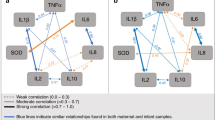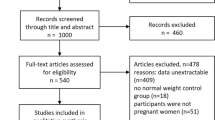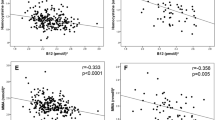Abstract
Background/Objective
Obesity increases maternal morbidity and adversely affects child health. Maternal inflammation may play a role in adverse outcomes. The objective of this study was to determine whether providing a higher dose of antioxidant micronutrients to pregnant women with obesity would raise concentrations of key antioxidant vitamins and impact inflammation and oxidative stress during pregnancy.
Subjects/Methods
This was a double-blind, randomized controlled trial. We recruited pregnant women with a body mass index (BMI) ≥ 30 kg/m2 at their initial prenatal visit ( < 13 weeks gestation) and collected blood and urine samples at baseline, 24–28 weeks, and 32–36 weeks to measure micronutrient concentrations (vitamin C, E, B6 and folate), markers of inflammation (C-reactive protein, interleukin-6, 8, and 1β) and oxidative stress (8-epi-PGF2α and malondialdehyde). We collected maternal and infant health data from enrollment to delivery as secondary outcomes. We enrolled 128 participants (64 in each arm), and 98 (49 in each arm) completed follow-up through delivery.
Intervention
Both groups received a standard prenatal vitamin containing the recommended daily allowance of micronutrients in pregnancy. In addition, the intervention group received a supplement with 90 mg vitamin C, 30 αTU vitamin E, 18 mg vitamin B6, and 800 μg folic acid, and the control group received a placebo.
Results
The intervention group had higher vit B6 (log transformed (ln), β 24–28 weeks: 0.76 nmol/L (95% CI: 0.40, 1.12); β 32–36 weeks: 0.52 nmol/L (95% CI: 0.17, 0.88)) than the control group. Vitamins C, E, erythrocyte RBC folate concentrations did not differ by randomization group. The intervention did not impact biomarkers of inflammation or oxidative stress. There were no differences in maternal or neonatal clinical outcomes by randomization group.
Conclusions
Higher concentrations of antioxidant vitamins during pregnancy increased specific micronutrients and did not impact maternal inflammation and oxidative stress, which may be related to dosing or type of supplementation provided.
Clinical trial registration
Clinical Trial Identification Number: NCT02802566; URL of the Registration Site: www.clinicaltrials.gov.
This is a preview of subscription content, access via your institution
Access options
Subscribe to this journal
Receive 12 print issues and online access
$259.00 per year
only $21.58 per issue
Buy this article
- Purchase on Springer Link
- Instant access to full article PDF
Prices may be subject to local taxes which are calculated during checkout


Similar content being viewed by others
Data availability
Limited data sets and data dictionaries will be made available by secure, electronic transmission from ten years of study publication to investigators who provide a detailed analysis plan that is agreed upon by the co-authors of this manuscript.
References
Cochrane L, Brumpton K, Winter S, Bell K, Burnham H, Wadwell K, et al. Prevalence and outcomes of overweight and obesity among pregnant women in rural Queensland. Aust J Rural Health. 2019;27:164–9. https://doi.org/10.1111/ajr.12495.
Begum KS, Sachchithanantham K, De Somsubhra S. Maternal obesity and pregnancy outcome. Clin Exp Obstet Gynecol. 2011;38:14–20.
Blomberg M. Maternal and neonatal outcomes among obese women with weight gain below the new Institute of Medicine recommendations. Obstet Gynecol. 2011;117:1065–70. https://doi.org/10.1097/AOG.0b013e318214f1d1.
Heslehurst N, Vieira R, Akhter Z, Bailey H, Slack E, Ngongalah L, et al. The association between maternal body mass index and child obesity: A systematic review and meta-analysis. PLOS Med. 2019;16:e1002817 https://doi.org/10.1371/journal.pmed.1002817.
Pantham P, Aye IL, Powell TL. Inflammation in maternal obesity and gestational diabetes mellitus. Placenta 2015;36:709–15. https://doi.org/10.1016/j.placenta.2015.04.006.
van der Burg JW, Sen S, Chomitz VR, Seidell JC, Leviton A, Dammann O. The role of systemic inflammation linking maternal body mass index to neurodevelopment in children. Pediatr Res. 2016;79:3–12. https://doi.org/10.1038/pr.2015.179.
Pantham P, Aye ILMH, Powell TL. Inflammation in maternal obesity and gestational diabetes mellitus. Placenta 2015;36:709–15. https://doi.org/10.1016/j.placenta.2015.04.006.
Christian LM, Porter K. Longitudinal changes in serum proinflammatory markers across pregnancy and postpartum: effects of maternal body mass index. Cytokine 2014;70:134–40. https://doi.org/10.1016/j.cyto.2014.06.018.
Stewart FM, Freeman DJ, Ramsay JE, Greer IA, Caslake M, Ferrell WR. Longitudinal assessment of maternal endothelial function and markers of inflammation and placental function throughout pregnancy in lean and obese mothers. J Clin Endocrinol Metab. 2007;92:969–75. https://doi.org/10.1210/jc.2006-2083.
Friis CM, Paasche Roland MC, Godang K, et al. Adiposity-related inflammation: effects of pregnancy. Obesity (Silver Spring). 2013;21:E124–130. https://doi.org/10.1002/oby.20120.
Madan JC, Davis JM, Craig WY, Collins M, Allan W, Quinn R, et al. Maternal obesity and markers of inflammation in pregnancy. Cytokine 2009;47:61–64. https://doi.org/10.1016/j.cyto.2009.05.004.
Shin D, Hur J, Cho EH, Chung HK, Shivappa N, Wirth M, et al. Pre-pregnancy body mass index is associated with dietary inflammatory index and C-Reactive protein concentrations during pregnancy. Nutrients 2017;9:351 https://doi.org/10.3390/nu9040351.
Sen S, Simmons RA. Maternal antioxidant supplementation prevents adiposity in the offspring of Western diet-fed rats. Diabetes 2010;59:3058–65. https://doi.org/10.2337/db10-0301.
Bjørke-Monsen AL, Ulvik A, Nilsen RM, Midttun O, Roth C, Magnus P, et al. Impact of pre-pregnancy BMI on B vitamin and inflammatory status in early pregnancy: an observational cohort study. Nutrients 2016;8:776 https://doi.org/10.3390/nu8120776.
O’Malley EG, Reynolds CME, Cawley S, Woodside JV, Molloy AM, Turner MJ. Folate and vitamin B12 levels in early pregnancy and maternal obesity. Eur J Obstet Gynecol Reprod Biol. 2018;231:80–84. https://doi.org/10.1016/j.ejogrb.2018.10.001.
Scholing JM, Olthof MR, Jonker FA, Vrijkotte TG. Association between pre-pregnancy weight status and maternal micronutrient status in early pregnancy. Public Health Nutr. 2018;21:2046–55. https://doi.org/10.1017/S1368980018000459.
Knight BA, Shields BM, Brook A, Hill A, Bhat DS, Hattersley A, et al. Lower Circulating B12 is associated with higher obesity and insulin resistance during pregnancy in a non-diabetic White British population. PLoS One. 2015;10:e0135268 https://doi.org/10.1371/journal.pone.013526817.
Sen S, Iyer C, Meydani SN. Obesity during pregnancy alters maternal oxidant balance and micronutrient status. J Perinatol. 2014;34:105–11. https://doi.org/10.1038/jp.2013.153.
Scholl TO, Chen X, Sims M, Stein TP. Vitamin E: maternal concentrations are associated with fetal growth. Am J Clin Nutr. 2006;84:1442–8. https://doi.org/10.1093/ajcn/84.6.1442.
Camier A, Kadawathagedara M, Lioret S, Bois C, Cheminat M, Dufourg MN, et al. Social inequalities in prenatal folic acid supplementation: Results from the ELFE cohort. Nutrients 2019;11:E1108 https://doi.org/10.3390/nu11051108.
Barchitta M, Maugeri A, Magnano San Lio R, Favara G, La Mastra C, La Rosa MC, et al. Dietary folate intake and folic acid supplements among pregnant women from Southern Italy: Evidence from the “Mamma & Bambino” Cohort. International Journal of Environmental Research and Public Health. 2020;17:638 https://doi.org/10.3390/ijerph17020638.
Behrens WA, Madère R. A highly sensitive high-performance liquid chromatography method for the estimation of ascorbic and dehydroascorbic acid in tissues, biological fluids, and foods. Anal Biochem. 1987;165:102–7. https://doi.org/10.1016/0003-2697(87)90206-5.
Camp VM, Chipponi J, Faraj BA. Radioenzymatic assay for direct measurement of plasma pyridoxal 5’-phosphate. Clin Chem. 1983;29:642–4.
Behrens W, Madère R. Malonaldehyde determination in tissues and biological fluids by ion-pairing high-performance liquid chromatography. Lipids. 1991;26:232–6.
Moher D, Schulz KF, Altman D. The CONSORT statement: revised recommendations for improving the quality of reports of parallel-group randomized trials. JAMA. 2001;285:1987e91.
Senn S. Testing for baseline balance in clinical trials. Stat Med. 1994;13:1715e26.
Senn SJ. Covariate imbalance and random allocation in clinical trials. Stat Med. 1989;8:467e75.
Pocock SJ, Assmann SE, Enos LE, Kasten LE. Subgroup analysis, covariate adjustment and baseline comparisons in clinical trial reporting: current practice and problems. Stat Med. 2002;21:2917e30.
Demirtas Hakan, Freels SallyA, Yucel RecaiM. Plausibility of multivariate normality assumption when multiply imputing non-Gaussian continuous outcomes: a simulation assessment. J Stat Comput Simulat. 2008;78:69–84. https://doi.org/10.1080/10629360600903866.
Oka M, Link CL, Kawachi I. Disparities in the Prevalence of Obesity in Boston: Results from the Boston Area Community Health (BACH) Survey. Public Health Rep. 2011;126:700 https://doi.org/10.1177/003335491112600512.
Masho SW, Bassyouni A, Cha S. Pre-pregnancy obesity and non-adherence to multivitamin use: findings from the National Pregnancy Risk Assessment Monitoring System (2009-11). BMC Preg Childbirth. 2016;16:210 https://doi.org/10.1186/s12884-016-1002-0.
Chiang EP, Smith DE, Selhub J, Dallal G, Wang YC, Roubenoff R. Inflammation causes tissue-specific depletion of vitamin B6. Arthritis Res Ther. 2005;7:R1254–1262. https://doi.org/10.1186/ar1821.
da Silva VR, Hausman DB, Kauwell GPA, Sokolow A, Tackett RL, Rathbun SL, et al. Obesity affects short-term folate pharmacokinetics in women of childbearing age. Int J Obes (London). 2013;37:1608–10. https://doi.org/10.1038/ijo.2013.41.
Violet PC, Ebenuwa IC, Wang Y, Niyyati M, Padayatty SJ, Head B, et al. Vitamin E sequestration by liver fat in humans. JCI Insight. 2020;5:e133309 https://doi.org/10.1172/jci.insight.133309.
Gagné A, Wei SQ, Fraser WD, Julien P. Absorption, transport, and bioavailability of vitamin E and its role in pregnant women. J Obstet Gynaecol Can. 2009;31:210–7. https://doi.org/10.1016/s1701-2163(16)34118-4.
Fan J, Ye J, Kamphorst JJ, Shlomi T, Thompson CB, Rabinowitz JD. Quantitative flux analysis reveals folate-dependent NADPH production. Nature 2014;510:298–302. https://doi.org/10.1038/nature13236.
Christen WG, Cook NR, Van Denburgh M, Zaharris E, Albert CM, Manson JE. Effect of Combined Treatment With Folic Acid, Vitamin B6, and Vitamin B12 on Plasma Biomarkers of Inflammation and Endothelial Dysfunction in Women. J Am Heart Assoc. 7:e008517. https://doi.org/10.1161/JAHA.117.008517
Chan AC. Partners in defense, vitamin E and vitamin C. Can J Physiol Pharmacol. 1993;71:725–31. https://doi.org/10.1139/y93-109.
Milczarek R, Klimek J, Zelewski L. The effects of ascorbate and alpha-tocopherol on the NADPH-dependent lipid peroxidation in human placental mitochondria. Mol Cell Biochem. 2000;210:65–73. https://doi.org/10.1023/a:1007007213846.
Chappell LC, Seed PT, Kelly FJ, Briley A, Hunt BJ, Charnock-Jones DS, et al. Vitamin C and E supplementation in women at risk of preeclampsia is associated with changes in indices of oxidative stress and placental function. Am J Obstet Gynecol. 2002;187:777–84. https://doi.org/10.1067/mob.2002.125735.
Chen H, Liu S, Ji L, Wu T, Ji Y, Zhou Y, et al. Folic Acid Supplementation Mitigates Alzheimer’s Disease by Reducing Inflammation: A Randomized Controlled Trial. Mediat Inflamm. 2016;2016:e5912146 https://doi.org/10.1155/2016/5912146.
Boots CE, Boudoures A, Zhang W, Drury A, Moley KH. Obesity-induced oocyte mitochondrial defects are partially prevented and rescued by supplementation with co-enzyme Q10 in a mouse model. Hum Reprod. 2016;31:2090–7. https://doi.org/10.1093/humrep/dew181.
Han L, Wang H, Li L, Li X, Ge J, Reiter RJ, et al. Melatonin protects against maternal obesity-associated oxidative stress and meiotic defects in oocytes via the SIRT3-SOD2-dependent pathway. J Pineal Res. 2017;63. https://doi.org/10.1111/jpi.12431
Jonscher KR, Stewart MS, Alfonso-Garcia A, DeFelice BC, Wang XX, Luo Y, et al. Early PQQ supplementation has persistent long-term protective effects on developmental programming of hepatic lipotoxicity and inflammation in obese mice. FASEB J. 2017;31:1434–48. https://doi.org/10.1096/fj.201600906R.
Ashor AW, Siervo M, Lara J, Oggioni C, Afshar S, Mathers JC. Effect of vitamin C and vitamin E supplementation on endothelial function: a systematic review and meta-analysis of randomised controlled trials. Br J Nutr. 2015;113:1182–94. https://doi.org/10.1017/S0007114515000227.
Hodkova M, Dusilova-Sulkova S, Kalousova M, Soukupova J, Zima T, Mikova D, et al. Influence of oral vitamin E therapy on micro-inflammation and cardiovascular disease markers in chronic hemodialysis patients. Ren Fail. 2006;28:395–9. https://doi.org/10.1080/08860220600683698.
Poston L, Briley AL, Seed PT, Kelly FJ, Shennan AH, Vitamins in Pre-eclampsia (VIP) Trial Consortium. Vitamin C and vitamin E in pregnant women at risk for pre-eclampsia (VIP trial): randomised placebo-controlled trial. Lancet 2006;367:1145–54. https://doi.org/10.1016/S0140-6736(06)68433-X.
Chappell LC, Seed PT, Briley AL, Kelly FJ, Lee R, Hunt BJ, et al. Effect of antioxidants on the occurrence of pre-eclampsia in women at increased risk: a randomised trial. Lancet. 1999;354:810–6. https://doi.org/10.1016/S0140-6736(99)80010-5.
Beazley D, Ahokas R, Livingston J, Griggs M, Sibai BM. Vitamin C and E supplementation in women at high risk for preeclampsia: a double-blind, placebo-controlled trial. Am J Obstet Gynecol. 2005;192:520–1. https://doi.org/10.1016/j.ajog.2004.09.005.
Rumbold AR, Crowther CA, Haslam RR, Dekker GA, Robinson JS, ACTS Study Group. Vitamins C and E and the risks of preeclampsia and perinatal complications. N Engl J Med. 2006;354:1796–806. https://doi.org/10.1056/NEJMoa054186.
Jamilian M, Mirhosseini N, Eslahi M, Bahmani F, Shokrpour M, Chamani M, et al. The effects of magnesium-zinc-calcium-vitamin D co-supplementation on biomarkers of inflammation, oxidative stress and pregnancy outcomes in gestational diabetes. BMC Preg Childbirth. 2019;19:107 https://doi.org/10.1186/s12884-019-2258-y.
Jamilian M, Hashemi Dizaji S, Bahmani F, Taghizadeh M, Memarzadeh MR, Karamali M, et al. A Randomized Controlled Clinical Trial Investigating the Effects of Omega-3 Fatty Acids and Vitamin E Co-Supplementation on Biomarkers of Oxidative Stress, Inflammation and Pregnancy Outcomes in Gestational Diabetes. Can J Diabetes. 2017;41:143–9. https://doi.org/10.1016/j.jcjd.2016.09.004.
Haghiac M, Yang X hua, Presley L, Smith S, Dettelback S, Minium J, et al. Dietary Omega-3 Fatty Acid Supplementation Reduces Inflammation in Obese Pregnant Women: A Randomized Double-Blind Controlled Clinical Trial. PLoS ONE. 2015;10. https://doi.org/10.1371/journal.pone.0137309
Zhu MJ, Du M, Nathanielsz PW, Ford SP. Maternal obesity upregulates inflammatory signaling pathways and enhances cytokine expression in th enhances cytokine expression in the mid-gestation sheep placenta. Placenta 2010;31:387–91.
Farley D, Choi J, Dudley DJ, Li C, Jenkins SL, Myatt L, et al. Placental amino acid transport and placental leptin resistance in pregnancies complicated by maternal obesity. Placenta 2010;31:718–24.
Leon-Garcia SM, Roeder HA, Nelson KK, Liao X, Pizzo DP, Laurent LC, et al. Maternal obesity and sex-specific differences in placental pathology. Placenta 2016;38:33–40.
Ditchfield A, Desforges M, Mills T, Glazier JD, Wareing M, Mynett K, et al. Maternal obesity is associated with a reduction in placental taurine transporter activity. Int J Obes. 2014;4:557–64.
Dube E, Gravel A, Martin C, Desparois G, Moussa I, Ethier-Chaisson M, et al. Modulation of fatty acid transport and metabolism by maternal obesity in the human fullterm placenta. Biol Reprod. 2012;87:1–11.
National Institutes of Health Office of Dietary Supplements. Dietary Supplements: What You Need to Know. https://ods.od.nih.gov/factsheets/WYNTK-Consumer/
Laraia BA, Bodnar LM, Siega-Riz AM. Pregravid body mass index is negatively associated with diet quality during pregnancy. Public Health Nutr. 2007;10:920–6. https://doi.org/10.1017/S1368980007657991.
Moran LJ, Sui Z, Cramp CS, Dodd JM. A decrease in diet quality occurs during pregnancy in overweight and obese women which is maintained post-partum. Int J Obes (Lond). 2013;37:704–11. https://doi.org/10.1038/ijo.2012.129.
American College of Obstetricians and Gynecologists. ACOG Committee opinion no. 549: obesity in pregnancy. Obstet Gynecol. 2013;121:213–7. https://doi.org/10.1097/01.aog.0000425667.10377.60.
Acknowledgements
We would like to thank the participants, without whom this study would not have been possible. We would also like to thank Annie Penfield-Cyr, MS and Charis Benjamin, BS for their important contributions to this study.
Funding
SS was supported by K23 HD 074648, K23 HD 074648 S1, and The Charles Hood Foundation.
Author information
Authors and Affiliations
Contributions
SS, SC, MH, MRH, TM, RF, EO, and SNM have all contributed to the study design, data acquisition, interpretation of results, and writing or revising the manuscript.
Corresponding author
Ethics declarations
Competing interests
The authors declare no competing interests.
Additional information
Publisher’s note Springer Nature remains neutral with regard to jurisdictional claims in published maps and institutional affiliations.
Supplementary information
Rights and permissions
Springer Nature or its licensor (e.g. a society or other partner) holds exclusive rights to this article under a publishing agreement with the author(s) or other rightsholder(s); author self-archiving of the accepted manuscript version of this article is solely governed by the terms of such publishing agreement and applicable law.
About this article
Cite this article
Sen, S., Cherkerzian, S., Herlihy, M. et al. Supplementation with antioxidant micronutrients in pregnant women with obesity: a randomized controlled trial. Int J Obes (2024). https://doi.org/10.1038/s41366-024-01472-z
Received:
Revised:
Accepted:
Published:
DOI: https://doi.org/10.1038/s41366-024-01472-z



